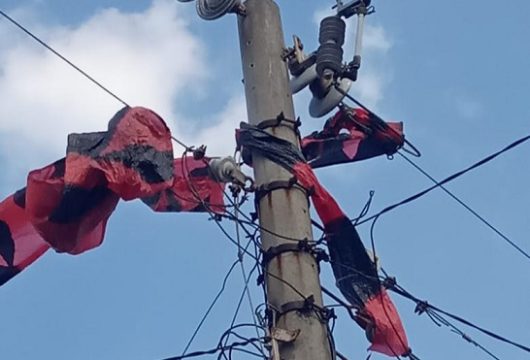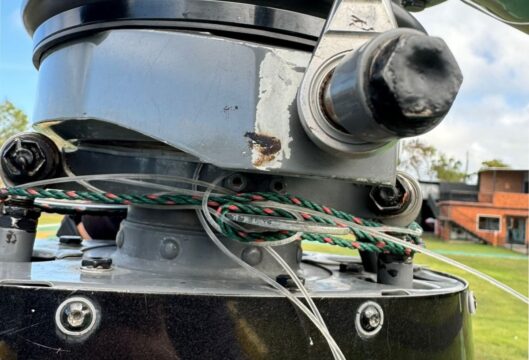Despite a long-standing provincial regulation published in 2000 restricting kite flying within a 54-kilometer radius of Bali’s Ngurah Rai Airport (Perda No. 9 Pasal 2 pada Perda Nomor 9/2000 tentang Larangan Menaikkan Layang-Layang Permainan Sejenis di Bandara Udara Ngurah Rai dan Sekitarnya), this rule sadly remains largely ignored and unenforced. Those seeking proof of any blatant failure of Bali officials to enforce the laws addressing kite flying and traffic safety need only look southward of an arch stretching east-to-west from Tabanan-Kintamani-Manggis all falling within the airspace restricted for kites flying.



Sadly, more concrete proof of the threat posed to aviation safety by errant kite flying in Bali is the separate downing of two commercial helicopters on 02 and 19 July 2024 when their rotors became entangled in kite lines. While the first incident resulted in an emergency landing, the second precipitated a crash landing near Suluban Beach, destroying a Bell 505 Helicopter that sent five passengers and crew to the hospital.
Recent Helicopter Mishaps in Bali
- 02 July 2024 Kite Downs Helicopter in South Bali
- 19 July 2024 Bali Helitour Helicopter Crashes in Pecatu
Passengers flying on fixed-wing aircraft and helicopters arriving and departing Bali’s Airport traffic pattern are frequently treated to a sudden and terrifying close-range view of large kites flying in mid-air near their aircraft. Adding to this dramatic situation is the frequent local practice of anchoring kites unsupervised overnight and even for subsequent days on end, creating a sustained and sometimes invisible threat to the safety of any aircraft flying in Bali after dark.
The Flight Rules: Kite Flying in Bali
The Provincial Law promulgated in 2000 sets particular altitude levels and spatial limits that are “mandatory” for governing the interaction of kites and other flying apparatus with all forms of commercial aircraft, namely:
- Within a 9 km radius of Bali’s Ngurah Rai Airport, no kites or “similar airborne apparatus” can be launched into flight.
- No kites or “similar airborne apparatus” can be flown at an altitude of more than 100 meters within a 9 km and 18 km radius from Bali’s Ngurah Rai Airport.
- No kites or “similar airborne apparatus” can be flown at an altitude of more than 300 meters within a radius of between 18 km and 54 km of Bali’s Ngurah Rai Airport.
Penalties
While enforcement of the kite restriction laws has been arguably lax, official penalties provide three months imprisonment or a fine of Rp. 5 million for any individual or persons involved in operating a kite in the restricted zone.
Other Airborne Apparatus
The limitations on flying in the “restricted zone” apply to kites, hot-air balloons, parasails, ultra-light aircraft, drones, and even fireworks.
Investigations continue into both incidents to determine what, including the regulations on kite flying, was violated. However, the head of the Bali Provincial Enforcement Authority (Satpol PP Bali), Dewa Nyoman Rai Darmadi, has admitted his teams are often outwitted by area residents who openly ignore the kite-flying regulations.
Somewhat surprisingly and to no small degree disingenuously, Darmadi is linking the problem to the failure of parents in Bali to control their children, when in fact, many kites are joint projects of local communities (banjars) dominated by older men.
Darmadi also admitted that enforcement of the kite-flying regulations, when it does take place, is done selectively. “In fact, in every international major event, we work with the State Power Board (PLN) and the airport authority to control kites. This takes place pre-event and post-event,” he explained.
When Satpol PP took action against erring kites, they discovered that their owners had deliberately tied them to trees and then returned home, leaving them unsupervised for days.
Commenting optimistically. Darmadi added: “Hopefully, all components of society will participate and play an active role in reminding and caring about kites that are flown high and how they can endanger air traffic and air transportation.”
More Severe Ramifications Ahead?
In light of the two recent helicopter downings in Bali linked to errant kite flying and a widespread view that government measures to reduce the kite-related threat to safety have proven ineffective or inadequate, fears are growing that there may be larger, even international ramifications ahead.
Some aviation industry observers are concerned that the Island’s tourism industry could be severely impacted if The International Civil Aviation Organization (ICAO) becomes involved or foreign governments that are the source nations for Balinese tourists, in an overabundance of caution, issue international travel warnings warning against air travel to and from Bali.
Related Links
02 July 2024 Kite Downs Helicopter in South Bali
19 July 2024 Bali Helitour Helicopter Crashes in Pecatu
Kites Near Bali’s Airport Threatens Safety
Stay Informed on Bali Tourism-Related News: Subscribe to Bali Update





